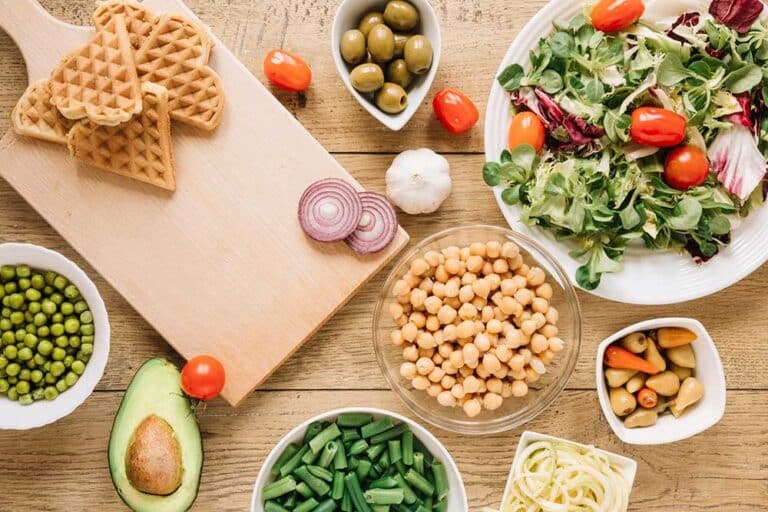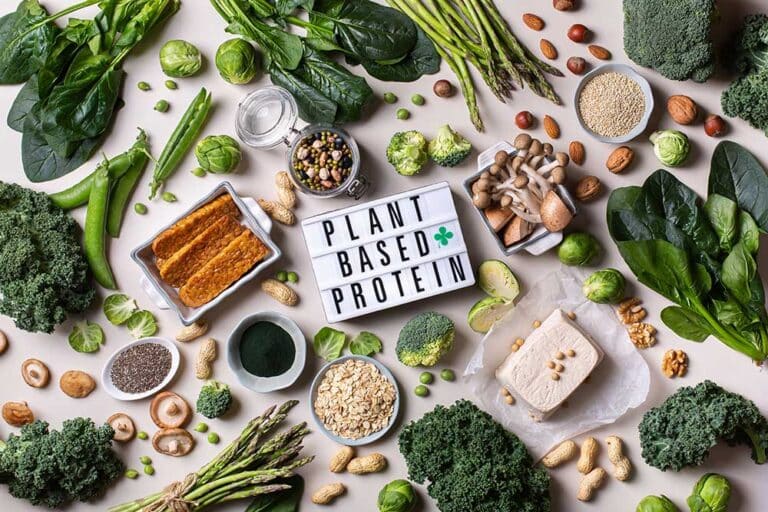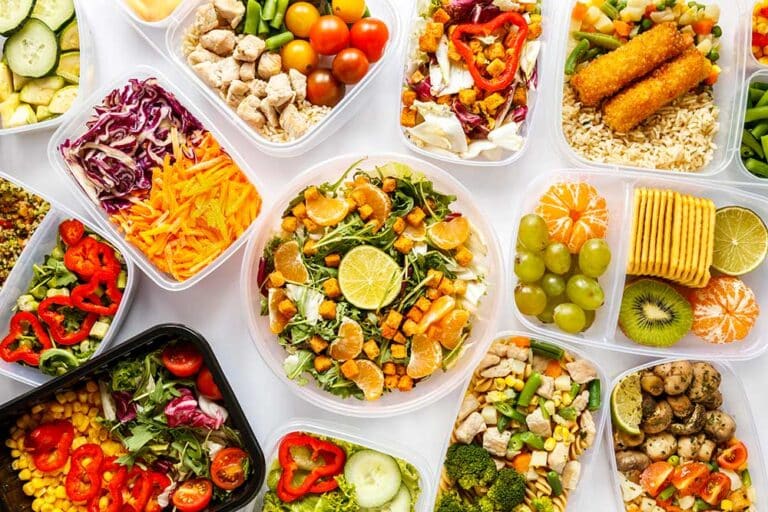Plant-Based Diet Basics
Understanding Plant-Based Eating
A plant-based diet focuses on consuming foods primarily from plants. This includes not only fruits and vegetables but also nuts, seeds, oils, whole grains, legumes, and beans (Harvard Health Publishing). It doesn’t mean that one must completely eliminate animal products but emphasizes that a larger proportion of what they eat comes from plant sources.
Key Components of a Plant-Based Diet:
- Fruits and Vegetables: Essential for vitamins, minerals, and fiber.
- Whole Grains: Includes brown rice, quinoa, and whole wheat products.
- Nuts and Seeds: Provides healthy fats and protein.
- Legumes and Beans: Rich in protein and fiber.
Benefits of a Plant-Based Diet
The benefits associated with a plant-based diet are abundant and can significantly contribute to optimal health.
Health Benefits:
-
Disease Prevention:
- Effective in managing cholesterol levels and heart health.
- Decreases risk of type 2 diabetes and certain cancers such as colon, breast, and prostate.
-
Heart Health:
- Reduces the risk of heart disease, metabolic syndrome, and hypertension (Parkview).
- A Mediterranean diet, which includes plant-based foods alongside fish and poultry, has been proven to enhance heart health.
-
Improvement of Other Health Conditions:
- Positively influences insulin sensitivity and blood cholesterol levels.
- Contributes to better mental and physical functions and manages weight effectively.
Environmental Benefits:
Opting for a plant-based diet also supports sustainable eating habits by reducing the environmental footprint associated with meat production.
The tables below represent the key nutrients and common sources found in a plant-based diet:
| Nutrient | Common Plant Sources |
|---|---|
| Protein | Tofu, Lentils, Chickpeas, Beans, Quinoa, Edamame |
| Fiber | Fruits, Vegetables, Whole Grains, Legumes |
| Healthy Fats | Avocado, Nuts, Seeds, Olive Oil |
For more details on the nutrients and benefits, explore our articles on plant-based diet benefits and benefits of plant-based eating.
By understanding and embracing the basics of a plant-based diet, individuals can make informed choices that benefit their health and the environment while enjoying a diverse and delicious array of foods.
Getting Started with a Plant-Based Diet
Transitioning to Plant-Based Eating
Transitioning to a plant-based diet can seem daunting, but it can be made easier with some practical tips and strategies. Starting gradually and making small, achievable goals can help ease the transition (Parkview). Here are some steps to consider:
- Start Slowly: Begin by incorporating more plant foods into your diet. Replace one meal a day with a plant-based option.
- Stock Healthy Foods: Keep a variety of plant-based foods like fresh fruits, vegetables, whole grains, legumes, nuts, and seeds in your pantry.
- Meal Planning: Plan your meals in advance and do meal prep a couple of times per week. This can save time and make daily meal choices easier.
- Replace Animal Products: Use plant-based alternatives for animal products. For example, use plant milks (oat, almond, soy), tofu scrambles, legumes, or tempeh instead of meat.
- Don’t Restrict Portions: Plant-based foods are lower in calories but higher in nutrients. Eating until satisfied without feeling restricted is key.
Different types of plant-based diets can be adopted based on individual preferences. Options include vegan, vegetarian, pescatarian, Mediterranean, and DASH diets. For more detailed recipes and meal ideas, visit our section on plant-based diet recipes.
Key Nutrients to Consider
When transitioning to a plant-based diet, it’s crucial to ensure that all essential nutrients are included. Here are some key nutrients to be aware of and their plant-based sources:
-
Protein: Essential for muscle maintenance and repair. Plant-based sources include lentils, chickpeas, quinoa, tofu, and tempeh. For more information, check out our guide on plant-based diet protein sources.
-
Iron: Important for blood health. Nonheme iron from plant foods is not as easily absorbed as heme iron from animal products. Pairing iron-rich foods like spinach, lentils, and chickpeas with vitamin C-rich foods such as bell peppers and citrus fruits can enhance absorption (Down to Earth).
-
Calcium: Necessary for bone health. Plant-based sources include fortified plant milks, leafy greens, almonds, and tofu.
-
Vitamin B-12: Crucial for nerve function. Generally not found in plant foods, so it’s important to consume fortified foods or take a supplement. Fortified foods include nutritional yeast, breakfast cereals, and non-dairy milk (Down to Earth).
-
Omega-3 Fatty Acids: Vital for heart health. Sources include flaxseeds, chia seeds, walnuts, and hemp seeds.
-
Zinc: Supports immune function. Found in legumes, seeds, nuts, and whole grains.
Here is a table summarizing the key nutrients and their plant-based sources:
| Nutrient | Plant-Based Sources |
|---|---|
| Protein | Lentils, Chickpeas, Quinoa, Tofu, Tempeh |
| Iron | Spinach, Lentils, Chickpeas, paired with Bell Peppers |
| Calcium | Fortified Plant Milks, Leafy Greens, Almonds, Tofu |
| Vitamin B-12 | Fortified Nutritional Yeast, Breakfast Cereals, Non-Dairy Milk |
| Omega-3 Fatty Acids | Flaxseeds, Chia Seeds, Walnuts, Hemp Seeds |
| Zinc | Legumes, Seeds, Nuts, Whole Grains |
Ensuring a balanced intake of these nutrients will help you maintain optimal health while following a plant-based diet. For more tips on creating a balanced meal plan, visit our section on plant-based diet meal plan.
Creating a Balanced Plant-Based Meal Plan
Transitioning to a plant-based lifestyle requires thoughtful planning to ensure a balanced diet that meets all nutritional needs. This section covers a 7-day meal plan for beginners and essential shopping tips for plant-based foods.
7-Day Meal Plan for Beginners
This 7-day meal plan is packed with nutrient-dense, plant-based recipes focusing on increasing the consumption of vegetables, fruits, whole grains, and legumes. These foods are high in fiber, a crucial nutrient that 95% of people don’t get enough of.
| Day | Breakfast | Lunch | Dinner | Snacks |
|---|---|---|---|---|
| Monday | Oatmeal with berries | Quinoa salad with chickpeas | Veggie stir-fry with tofu | Carrot sticks, Hummus |
| Tuesday | Smoothie with spinach and banana | Lentil soup | Whole grain pasta with marinara sauce | Mixed nuts, Apple slices |
| Wednesday | Avocado toast | Veggie wrap with hummus | Black bean chili | Fresh fruit, Almonds |
| Thursday | Chia pudding with almond milk | Mixed green salad with quinoa | Stuffed bell peppers | Rice cakes, Peanut butter |
| Friday | Green smoothie bowl | Spaghetti squash with marinara | Sweet potato and black bean tacos | Celery sticks, Guacamole |
| Saturday | Whole grain toast with almond butter | Vegetable sushi rolls | Eggplant parmigiana | Trail mix, Orange slices |
| Sunday | Pancakes with maple syrup | Buddha bowl with brown rice | Stir-fried tempeh with vegetables | Dried fruits, Sunflower seeds |
For more ideas and recipes, visit our plant-based diet recipes.
Shopping Tips for Plant-Based Foods
Shopping for a plant-based diet involves selecting wholesome, minimally processed foods. Here are key tips to help you make better choices:
-
Focus on Whole Foods: Prioritize fruits, vegetables, whole grains, legumes, nuts, and seeds. These food items are rich in essential nutrients and form the backbone of a plant-based diet (Harvard Health Publishing).
-
Protein Sources: Choose minimally processed sources of protein like beans, lentils, nuts, and whole grains. Limit heavily processed vegetarian proteins such as soy “hot dogs” or imitation meats, which often contain high sodium levels and fewer nutritional benefits. For more on protein, read about plant-based diet protein sources.
-
Buy in Bulk: Purchasing whole grains, beans, nuts, and seeds in bulk can be cost-effective and ensures you always have essentials on hand.
-
Seasonal and Local Produce: Opt for seasonal and locally grown fruits and vegetables. They are fresher, more flavorful, and often more affordable.
-
Read Labels: When buying packaged foods, read labels to avoid added sugars, unhealthy fats, and excessive sodium.
-
Plan Ahead: Create a meal plan and shopping list before heading to the store. This helps you avoid impulse purchases and stick to your plant-based dietary goals. For help with planning, check out our plant-based diet meal plan.
By following these tips and utilizing the 7-day meal plan, you can smoothly transition to a plant-based diet and reap its many health benefits. More detailed advice on nutrition and healthful eating can be found in our section on the benefits of plant-based eating.
Health Benefits of a Plant-Based Diet
Switching to a plant-based diet offers numerous health advantages. Let’s explore how this dietary approach can contribute to disease prevention and promote heart health.
Disease Prevention
A plant-based diet has been associated with a reduced risk of several chronic diseases. This dietary approach emphasizes whole foods like vegetables, fruits, legumes, nuts, and seeds, which are rich in essential nutrients and antioxidants.
According to Harvard Health Publishing, vegetarian diets can lower the risk of coronary heart disease, high blood pressure, diabetes, and may even contribute to increased longevity. The high fiber content in plant foods aids in regulating blood sugar levels and can help prevent Type 2 diabetes.
Additionally, the Cleveland Clinic notes that plant-based diets help decrease the risk of digestive diseases, colon and breast cancers, and obesity. This makes plant-based eating a powerful tool for both disease prevention and improved overall health.
Positive Impact on Heart Health
Plant-based diets are particularly beneficial for heart health. They can significantly improve cholesterol levels and decrease the risk of heart disease.
The table below shows how a diet rich in plant-based foods can impact heart-related health metrics:
| Health Metric | Impact of Plant-Based Diet |
|---|---|
| Cholesterol Levels | Lower LDL and total cholesterol |
| Blood Pressure | Reduced risk and better control of high blood pressure |
| Heart Disease Risk | Reduced incidence of coronary artery disease |
(Source: Everyday Health)
Plant-based diets are high in dietary fiber, which helps to lower cholesterol by binding bile acids during digestion and preventing their reabsorption. This, combined with the absence of cholesterol in plant foods, contributes to improved lipid profiles and heart health.
For people starting on this dietary journey, incorporating a balanced and varied intake of plant-based foods is crucial. To help with proper planning, here is a 7-day meal plan for beginners.
For more information on protein sources that support heart health and overall well-being, explore our guide on plant-based diet protein sources.
By understanding these health benefits, individuals can make informed decisions about adopting a plant-based diet and reaping its numerous health rewards. Visit our article on the benefits of plant-based eating for more in-depth insights.
Sustainability and Plant-Based Eating
Environmental Benefits
Adopting a plant-based diet is not just beneficial for health; it also significantly impacts the environment positively. Concerns over global warming have led to people seeking more environmentally sustainable food options, with plant-based proteins generally considered more sustainable than animal proteins. The EAT-Lancet Commission’s report emphasizes that transforming to healthy diets by 2050 will require substantial dietary shifts. This includes a doubling of global consumption of fruits, vegetables, nuts, and legumes, and a reduction by more than 50% in the consumption of red meat and sugar.
| Environmental Impact | Plant-Based Diets | Animal-Based Diets |
|---|---|---|
| Greenhouse Gas Emissions | Lower | Higher |
| Land Use | Less | More |
| Water Consumption | Less | More |
By choosing plant-based foods, individuals contribute to a decrease in greenhouse gas emissions, reduced land use, and lower water consumption. For further details about the health effects of plant-based diets, see benefits of plant-based eating.
Challenges and Solutions
Despite the clear environmental benefits, several challenges need to be addressed when adopting a plant-based diet sustainably. One main challenge is the environmental impact of certain plant-based options. While legume production generally has a lower environmental footprint, the sustainability of meat alternatives remains debated. Additionally, plant-based milk alternatives, such as almond milk, have gained popularity, but some, like almond milk, involve significant irrigation, which can be environmentally taxing.
To navigate these challenges, consider these solutions:
- Prioritize legumes, grains, and local produce to reduce environmental impact.
- Opt for plant-based milk alternatives with a lower environmental footprint, such as oat milk or locally-produced options.
- Educate oneself about sustainable agricultural practices and support brands that prioritize sustainability.
- Incorporate a wider variety of plant-based protein sources in your diet. For more information on this, read our article on plant-based diet protein sources.
| Challenge | Solution |
|---|---|
| High water usage (e.g., almond milk) | Choose lower-impact alternatives like oat milk |
| Debated sustainability of meat alternatives | Focus on whole, minimally processed plant foods |
For a holistic approach to following a plant-based diet, including meal planning and nutritional advice, check out our comprehensive guide on plant-based diet for beginners.
Trends in Plant-Based Diets
Growth of Plant-Based Food Market
The plant-based food market has experienced substantial growth in recent years, fueled by increasing consumer awareness of health and environmental benefits associated with a plant-based diet (PMC). As people are prioritizing optimal health and sustainable eating habits, the demand for plant-based alternatives continues to rise.
Market Growth Data
| Year | Global Market Value (in Billion USD) |
|---|---|
| 2018 | 10.3 |
| 2019 | 12.1 |
| 2020 | 13.9 |
| 2021 | 15.8 |
| 2022 | 18.3 |
| 2023 (Projected) | 20.6 |
This substantial market growth is a testament to the increasing shift towards plant-powered living. Consumers are seeking products such as plant-based milk, meat alternatives, and various other vegan options. These products are cropping up in grocery stores and restaurants, making it easier than ever to adopt a plant-based lifestyle.
For those starting a plant-based diet, having a well-rounded understanding of the available options is crucial. Explore our plant-based diet for beginners guide for a detailed intro.
Challenges in Adopting Plant-Based Diet
Despite the numerous benefits and growing popularity, adopting a plant-based diet comes with its own set of challenges. Understanding these challenges can help individuals better prepare for and navigate the transition to a plant-based lifestyle.
Food Neophobia and Ingredients Availability
One of the primary challenges consumers face is food neophobia – a reluctance to try novel or unfamiliar foods. Many individuals find vegetarian and vegan diets to be inconvenient due to difficulties in cooking, preparation, and the accessibility of ingredients. Additionally, taste, texture, appearance, and mouthfeel are significant factors affecting consumer acceptance of plant-based alternatives.
Nutrition and Dietetics
Another challenge lies in ensuring a balanced diet that provides all the necessary nutrients. Adequate selection and combination of foods is essential in preventing nutritional deficiencies. Nutrients such as protein, iron, calcium, and vitamin B12 require careful planning. For guidance on key nutrients to consider, refer to our section on key nutrients to consider.
Sustainability
While the plant-based diet is generally considered more sustainable, there are still environmental impacts to consider. For instance, while legume production has a lower environmental footprint, the sustainability gains from certain meat alternatives remain debated. Although plant-based milk alternatives are popular, some like almond milk have significant environmental costs due to irrigation needs (PMC). Addressing these sustainability challenges will be crucial in the continued growth of the plant-based market.
By understanding these challenges, individuals can make informed decisions and overcome obstacles as they transition to a plant-based diet. For further tips on starting a plant-based lifestyle, check out our resources on plant-based diet meal plan and plant-based diet recipes.
- About the Author
- Latest Posts
Johnnie D. Jackow Sr., the founder and CEO of Total Body Fitness, Worldwide, has a long-standing career in the fitness industry. He began as a certified personal trainer in the mid-90s and soon after authored his first weight loss book in 1998. This led to the launch of Total Body Fitness, Nationwide in the USA at the same time. Johnnie gained recognition as the fitness guru of his time, running infomercials on local TV late at night in Houston, Texas. Over the years, he has helped more than 40,000 individuals from all over the world achieve their health and fitness goals. With over 60,000 hours of documented training in integrative functional medicine, he completed his PhD in human physiology in 2010. His primary objective is to assist people in reaching their health and fitness goals through alternative approaches rather than relying solely on conventional medicine and pharmaceutical drugs. Today, with almost three decades of experience under his belt, Johnnie continues to be a leader in health and fitness.








